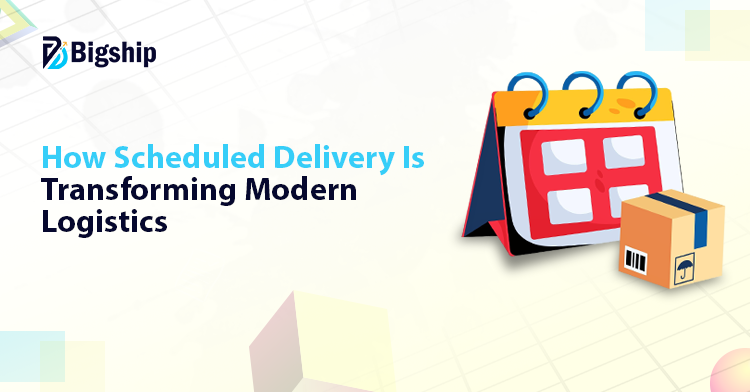In today’s fast-paced world, fast-moving logistics is the key to market success and meeting customer demands. Companies have been inventing newer ways to speed up the shipping process so that they can meet the customer’s expectations. And scheduled delivery is one of the approaches that has gained attention. As businesses aim to maximise operations combined with great services, knowing what advantages scheduled delivery offers becomes essential.

Let’s dive into why this method is the backbone of modern-day logistics plans.
An overview of Scheduled Delivery
Scheduled delivery is one special shipping option where customers can choose the date or time window for when they want to receive an order. It becomes the most approachable option in eCommerce, where timely and predictable delivery is the key to ensuring customer satisfaction.
By being very specific about the time an order will reach, both the sender and the receiver can plan, thereby cutting missed appointments and improving the efficiency of logistics on the receiving end. Scheduled delivery thus offers flexibility, eases operations, and makes the entire delivery experience pleasant for all involved.
How Does Scheduled Delivery Work?
Scheduled delivery works on a very systematic and precise channel to allow orders to be fulfilled on time and with convenience for both businesses and individual customers. The process is carefully planned, considering factors like delivery distance, traffic conditions, and transport options.
The process starts with coordination between the sender, the carrier, and the receiver. At checkout, the customer is typically presented with a selection of delivery time slots, from which they can specify the time that best suits their schedule. Once selected and confirmed, the logistics provider arranges for the actual shipment to be done within the time scheduled.
This system optimizes delivery routes, allowing for on-time arrivals, considering real-time traffic and geographical situations. Incidentally, in some cases, the date of delivery may be decided on by the shipper or courier partners on the basis of operational availability.
Step-by-Step Process of Scheduled Delivery
- Inventory Monitoring and Order Control: Incoming and outgoing orders are tracked. In cases of discrepancy, the respective entities can promptly alert the business. A real-time visibility of orders allows the business to ensure that deliveries proceed smoothly and are executed on time.
- Optimizing Delivery Routes: After confirming orders, delivery routes are planned. Advanced routing techniques help identify the most efficient paths so drivers avoid traffic, cut down on travel time, and cut fuel expenses, hence improving the overall efficiency of delivery.
- Trip Scheduling and Resource Allocation: Deliveries are grouped into trips and assigned to suitable vehicles based on package size, weight, and destination. Drivers receive optimized routes and schedules so that every order is delivered on time and with complete accuracy.
Best Practices for Effective Scheduled Delivery
Successfully implementing scheduled delivery requires a strong strategy that balances customer satisfaction, operational efficiency, and cost control. Some best practices listed below will ensure that your scheduled delivery processes run smoothly:
1. Give Importance to Clear Communication: Customer communication must be maintained, as they should know what the status is. Using real-time tracking and clear messages builds trust and customer acceptance.
2. Deliver Clear and Timely Notifications of Delivery: Provide updates, using email, SMS, or mobile app alerts. This will help in preventing confusion from occurring and missing deliveries.
3. Provide Responsive Customer Support: Train the support team to handle questions related to delivery with great expertise and professionalism. Create a list of delivery-related questions and train the support team to handle them confidently. Be sure customers will have more channels to reach the company, whether by phone, email, or live chat.
Estimated vs. Actual Delivery Dates: The Differences
In logistics, from the perspective of business and customer, it is very important to realize the difference between Estimated Delivery Dates (EDD) and Actual Delivery Dates. Even though these terms may be used interchangeably in everyday language, they represent two very distinct delivery processes.
| Estimated Delivery Date (EDD) | Actual Delivery Date |
| It is the projected time within which the package is expected to be in the recipient’s hands. | It is the real date when a package is delivered and handed over to the intended recipient. |
| EDD is determined depending on the type of shipment, carriers’ capabilities, volume of carriers, weather, and sometimes the peculiarities of the final destination. | Actual Delivery Date depends on the time taken to process the order, what’s in stock, and how soon the order can be sent out. |
| EDD is influenced by distance, capacity of the transporter, perhaps speed of the sender to fulfill an order, and occurrences that disturb the transport schedule. | The Actual Delivery Date is determined by the availability of goods, time to process the order, and actual execution. |
| EDD may be altered due to exceptions such as heavy weather, backlogs in operations, and interrupted transits. Customers may get updates or even see “delivery pending”. | It shows the outcome of the delivery process. If the shipment is delayed, this is where it will be specified. |
| EDD sets customer expectations by offering a timeframe for package arrival. | Actual Delivery Date is the confirmation of the exact date on which the customer receives the package. |
| EDD can change any number of times as the tracking information is updated or unforeseen delays occur. | It’s a fixed date based on when it’s delivered, and it’s the final date. |
Why Scheduled Delivery Continues to Be Popular?
Scheduled delivery, also known as planned delivery, combines convenience, cost-effectiveness, and operational efficiency. Because of the compelling reasons described below-
- Convenience for All Parties Involved: Scheduled delivery allows shippers, carriers, and customers to agree on a delivery time that suits all parties. This collaborative process improves customer experience while minimizing missed deliveries.
- Cost-Efficiency: Typically, scheduled delivery costs less than on-demand or same-day delivery. This helps to optimize route planning, reduced fuel consumption, and maximize vehicle capacities, which translates to big cost savings.
- Operational Control: Because the deliveries are planned, carriers and fulfillment teams can more strategically organize routes and load vehicles, which assists in streamlining operations. This planning leads to fewer trips and saves time and resources.
Difference between Scheduled Delivery and On-Demand Services
In deciding between on-demand and scheduled delivery, it’s critical to balance the advantages of each according to your particular requirements. Here’s a side-by-side table to help you decide:
| On-Demand Delivery | Scheduled Delivery |
| Delivered quickly within minutes or hours. | Planned deliveries are made with advance notice. |
| Typically, more expensive due to urgency. | More affordable, with cost-saving route optimization. |
| Highly flexible, adjusts in real time. | Limited flexibility, follows pre-set schedules. |
| Ideal for urgent needs—food, parcels, or last-minute items. | Best for planned shipments, bulk items, or routine deliveries. |
| Its efficiency may be lower during peak demand periods. | High efficiency through route planning. |
| Fulfilled from nearby stores or local hubs. | Usually shipped from larger warehouses or distribution centers. |
| Real-time tracking with shorter windows. | Tracking is available with defined time slots. |
| It can be less reliable during demand spikes. | More reliable due to scheduled planning. |
| Higher emissions due to frequent, rushed trips. | Lower emissions via consolidated routes. |
| Suited for single, urgent deliveries. | Suited for bulk, large, or periodic deliveries. |
Challenges of Implementing Scheduled Delivery
Several challenges need to be overcome when implementing a scheduled delivery operation. Here are the issues and how they impact your operation:
Complex coordination: Where deliveries are coordinated between multiple locations and several carriers with different customer preferences in delivery time, utmost consideration must go into planning. Mismanagement might cause delays or rescheduling in deliveries.
Capacity and Resource Management: Managing delivery schedules while optimizing fleet usage and warehouse inventory can be a challenging task.
Accommodating Last-Minute Changes: Customers can request changes in delivery time, location, or even priority if scheduled, and this can create chaos if not handled properly.
Maintaining Clarity in Communication: Disturbances concerning status, delays, or changes should be communicated to customers. Lack of communication can create frustration or a trust issue.
Meeting Changing Customer Expectations: Today, customers want on-time and speedy deliveries. Failing to meet expectations can lose customers and can result in negative reviews.
Key Advantages of Scheduled Delivery
Here are some key advantages of scheduled delivery for your business:
- Enhanced Customer Satisfaction: Give customers the choice to choose a preferred delivery window. This will improve their overall experience and also build trust.
- Fewer Missed Deliveries: Scheduling the delivery time can reduce the missed deliveries by allowing customers to align the delivery time.
- Improved Operational Efficiency: Planning helps businesses to optimize routes and resources, which lowers operational costs.
- Optimized Resource Utilisation: Scheduling deliveries allows better management of fleet capacity and reduces cost.
- Reduced Risk of Theft and Damage: When customers are available to receive the delivery, this can reduce the theft or loss and ensure it reaches them safely.
- Improved Cost-Effectiveness: Compared to other on-demand options, scheduled delivery is more cost-effective, helping businesses manage shipping expenses and meet the customers’ needs.
- Streamlined Delivery Workflow: Scheduled delivery helps to reduce the last-minute chaos, lower transportation costs, and help to smooth logistic operations.
Conclusion
In today’s world, customers want reliability, transparency, and control. Hence, scheduled delivery has become an essential component of today’s logistics, providing the capability of planning deliveries in designated time slots most convenient for customers. Unlike conventional forms of delivery, scheduled delivery provides accuracy and minimizes missed pickups.
Scheduled delivery increases customer satisfaction, reduces operations complexity, and optimizes fleet utilization. Not only does this assist in cost-efficient resource use, but it also
helps businesses to meet the expectations of customers and aligns with the demands of today’s dynamic marketplace.
At Bigship, secure shipping is our promise. So, sign up today and schedule your delivery time as per your convenience.





